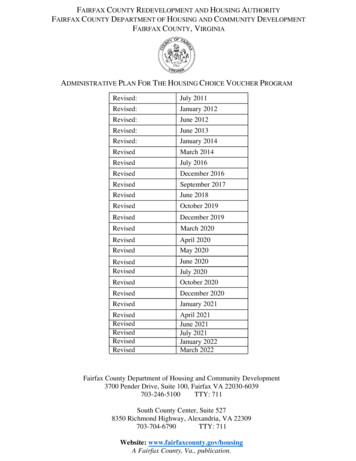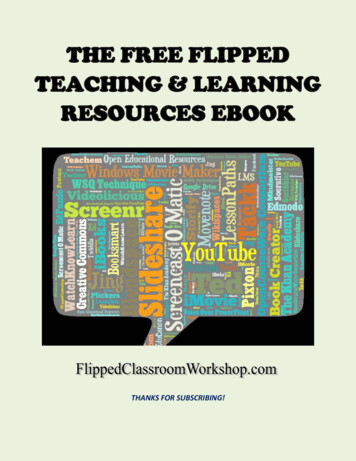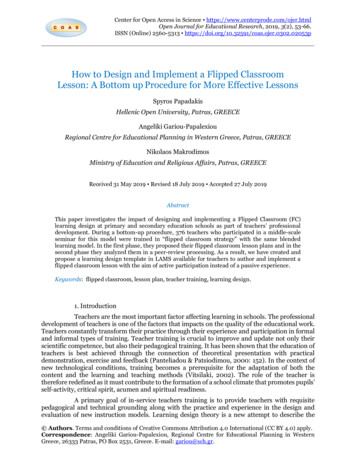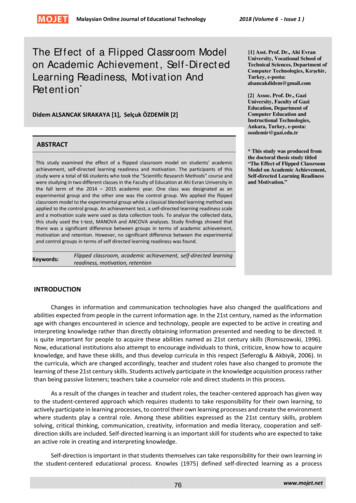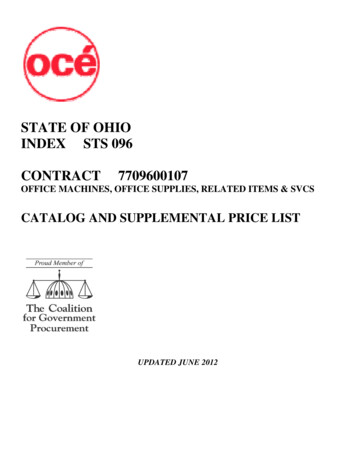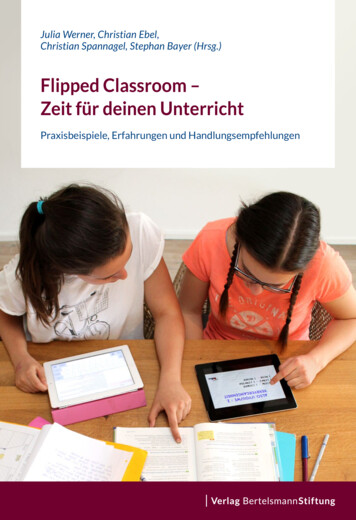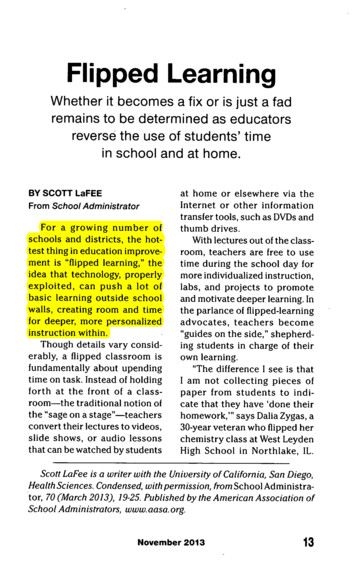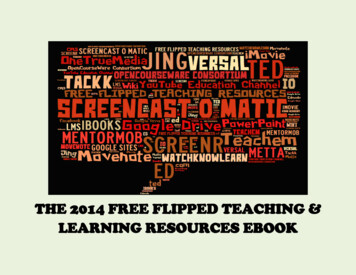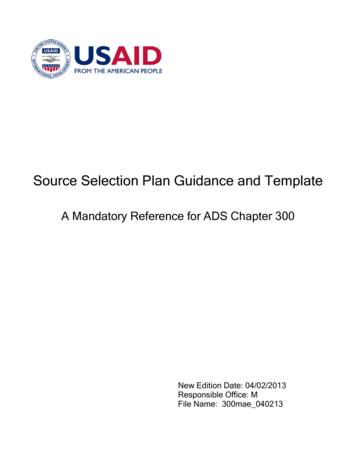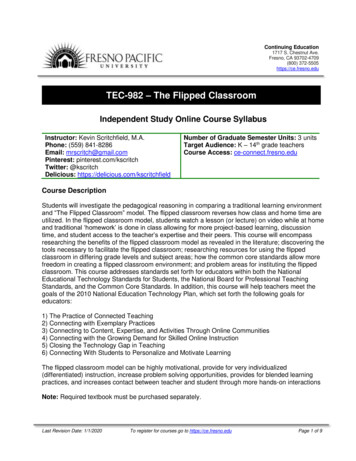
Transcription
Continuing Education1717 S. Chestnut Ave.Fresno, CA 93702-4709(800) 372-5505https://ce.fresno.eduTEC-982 – The Flipped ClassroomIndependent Study Online Course SyllabusInstructor: Kevin Scritchfield, M.A.Phone: (559) 841-8286Email: mrscritch@gmail.comPinterest: pinterest.com/kscritchTwitter: @kscritchDelicious: https://delicious.com/kscritchfieldNumber of Graduate Semester Units: 3 unitsTarget Audience: K – 14th grade teachersCourse Access: ce-connect.fresno.eduCourse DescriptionStudents will investigate the pedagogical reasoning in comparing a traditional learning environmentand “The Flipped Classroom” model. The flipped classroom reverses how class and home time areutilized. In the flipped classroom model, students watch a lesson (or lecture) on video while at homeand traditional ‘homework’ is done in class allowing for more project-based learning, discussiontime, and student access to the teacher’s expertise and their peers. This course will encompassresearching the benefits of the flipped classroom model as revealed in the literature; discovering thetools necessary to facilitate the flipped classroom; researching resources for using the flippedclassroom in differing grade levels and subject areas; how the common core standards allow morefreedom in creating a flipped classroom environment; and problem areas for instituting the flippedclassroom. This course addresses standards set forth for educators within both the NationalEducational Technology Standards for Students, the National Board for Professional TeachingStandards, and the Common Core Standards. In addition, this course will help teachers meet thegoals of the 2010 National Education Technology Plan, which set forth the following goals foreducators:1) The Practice of Connected Teaching2) Connecting with Exemplary Practices3) Connecting to Content, Expertise, and Activities Through Online Communities4) Connecting with the Growing Demand for Skilled Online Instruction5) Closing the Technology Gap in Teaching6) Connecting With Students to Personalize and Motivate LearningThe flipped classroom model can be highly motivational, provide for very individualized(differentiated) instruction, increase problem solving opportunities, provides for blended learningpractices, and increases contact between teacher and student through more hands-on interactionsNote: Required textbook must be purchased separately.Last Revision Date: 1/1/2020To register for courses go to https://ce.fresno.eduPage 1 of 9
Required Texts and Course MaterialsTextbook: Bergmann, J., & Sams, A. (2012). Flip Your Classroom: Reach Every Student in EveryClass Every Day. Eugene, OR: International Society for Technology in Education. ISBN-13: 9781564843159. g-Student/dp/1564843157Note: Students are responsible for purchasing their own textbook, analyzing the content, andapplying what they learned to the course assignments. You are welcome to purchase used, ebook,or new versions to save money. You can order the book directly from the publisher or from one ofseveral discount aggregators (for example): http://books.nettop20.comOnline Resources: Relevant online resources that support the course content and encouragefurther investigation will be available throughout the course assignments. Active hyperlinks areutilized throughout the course and will link to the appropriate information when clicked. Theseinclude videos, podcasts, worksheets, online activities, journal articles and other resources.Moodle: Moodle is a web-based learning management system used to support flexible teachingand learning in both face-to-face and distance courses (e-learning).https://moodle.org // https://moodle.org/demo // https://docs.moodle.orgCourse DatesSelf-paced; students may enroll at any time and take up to one year, from the date of registration, tocomplete assignments. Students may complete assignments in no less than three weeks for a 3unit course (one week per unit).National Standards Addressed in This CourseNational Board for Professional Teaching Standards ropositions/)First published in 1989 and updated in 2016, What Teachers Should Know and Be Able to Doarticulates the National Board’s Five Core Propositions for teaching. The Five Core Propositions comparable to medicine’s Hippocratic Oath — set forth the profession’s vision for accomplishedteaching. Together, the propositions form the basis of all National Board Standards and thefoundation for National Board Certification. Course assignments have been designed so studentscan demonstrate excellence against these professional teaching standards whenever possible. Proposition 1: Teachers are committed to students and their learning Proposition 2: Teachers know the subject they teach and how to teach those subjects to students Proposition 3: Teachers are responsible for managing and monitoring student learning Proposition 4: Teachers think systematically about their practice and learn from experience Proposition 5: Teachers are members of learning communitiesNational Educational Technology Standards (NETS)1. Facilitate and Inspire Student Learning and Creativity2. Design and Develop Digital-Age Learning Experiences and Assessments3. Model Digital-Age Work and Learning4. Promote and Model Digital Citizenship and Responsibility5. Engage in Professional Growth and LeadershipLast Revision Date: 1/1/2020To register for courses go to https://ce.fresno.eduPage 2 of 9
Continuing Education Program Student Learning OutcomesCE 1CE 2CE 3CE 4CE 5CE 6Demonstrate proficient written communication by articulating a clear focus,synthesizing arguments, and utilizing standard formats in order to inform andpersuade others, and present information applicable to targeted use.Demonstrate comprehension of content-specific knowledge and the ability to apply itin theoretical, personal, professional, or societal contexts.Reflect on their personal and professional growth and provide evidence of how suchreflection is utilized to manage personal and professional improvement.Apply critical thinking competencies by generating probing questions, recognizingunderlying assumptions, interpreting and evaluating relevant information, andapplying their understandings to the professional setting.Reflect on values that inspire high standards of professional and ethical behavior asthey pursue excellence in applying new learning to their chosen field.Identify information needed in order to fully understand a topic or task, organize thatinformation, identify the best sources of information for a given enquiry, locate andcritically evaluate sources, and accurately and effectively share that information.Student Learning Outcomes (SLOs) for This CourseStudent Learning Outcomes for This CourseBy the end of this course student will be able to:1. Model digital age work and learning throughthe process of each lesson delivery andassessment2. Engage in professional growth andleadership by participating in local and globallearning communities, demonstrate a visionof technology infusion, participate in buildinglearning communities, evaluate and reflecton current research and professionalpractice to make use of existing andemerging digital tools for student learning3. Advocate, model, and teach digital etiquetteand responsible social interactions relating tothe use of technology and information4. Use innovative tools to formulate activitiesthat enhance their teaching and interactionswith their peers and students.5. Develop and design digital learningexperiences to promote diverse learningstyles and skills including assessment types.6. Locate, evaluate, and analyze online toolsfor the purpose of sharing with andinstructing their peers as well as studentsand their parents on the benefits andLast Revision Date: 1/1/2020National StandardsAddressed in ThisCourse*ContinuingEducation ProgramStudent LearningOutcomesAddressed**NETS 3a,b,c,d andNBPTSNETS 5a,b,c,d andNBPTS 5a,b,c,eNETS 4a,c,dNETS 1a,c,d, 2a,b,cand NETS 3a,d,4a,c, 5a,cNETS 2a,b,c,d,NBPTS 1a,b,c,d,2a,b,c, 3a,b,c,d,4d, 5aNETS 3a,b,c,d andNBPTS 4a,c,5a,c,d,eTo register for courses go to https://ce.fresno.eduPage 3 of 9
advantages of implementing these toolswithin the flipped classroom environment.7. Identify methodologies that incorporate theease of equitable access, including accessto others around the world.8. Demonstrate a vision for technology infusioninto their classroom and personal life whilecontributing to their effectiveness, vitality,and self-renewal by participating in theglobal community of educators through theuse of these online tools.9. Critically analyze and reflect on benefits anddrawbacks of the flipped classroomapproach based on curricular need.10. Collaborate with others using online toolsand demonstrate how to locate or createvideo and other teaching materials for homeuse by students for a specific instructionalneed.11. Create project-based learning units andassessment action plans and field testflipped classroom approach anddemonstrate ability to determine acurricular/training fit in instructional decisionmaking.12. Design cooperative learning and peertutoring activities using the flipped classroomapproach and utilize self and groupassessment rubrics to assess group workand team activities.13. Critique scenarios and analyze bestpractices for effective classroommanagement in the flipped classroom tominimize disruptive behavior and increaseengaged learning14. Interpret assessment results of field testsand assess the effectiveness in supportingidentified learner outcomes.NETS 4b,d andNBPTS 1a,b,d,3a, 4cNETS 5b,c,d, NBPTS4c, 5a,c,d,eNETS 1a,b,c,d,2a,b,c,d, 3a,d, 4band NBPTS2a,b,c, 3a,b,c,d,4a,b,cNETS 2a,b,c,3a,b,c,d, 5a,b,c,dand NBPTS5a,c,dNETS 1a,b,c,d,2a,b,c, andNBPTS 2cNETS 1c,d, 2d, 5band NBPTS 2c,5aNETS 2a,b,c, 5c andNBPTS 2c, 3a,bNETS 1c, 2a,b,c,d,4b,d and NBPTS3b,c,d* Please refer to the section on National Standards Addressed in This Course** Please refer to the section on Continuing Education Program Student Learning OutcomesLast Revision Date: 1/1/2020To register for courses go to https://ce.fresno.eduPage 4 of 9
Topics, Assignments, and ActivitiesModuleModule TitleModule Assignments and ActivitiesWelcome Module Module 1 Module 2Module 3Module 4Module 5Module 6Module 7Course Wrap-up –Grading andEvaluationPointsPossiblefor EachAssignmentIntroduction videoCourse SyllabusIntroduce Yourself ForumMoodle Online TutorialResearch and reflect on what the literature statesconcerning the positive and negative elements of theflipped classroom in comparison to the traditionalclassroom. Create a video lesson in several different formats Discover the necessary tools to create a flippedclassroom environment Create an online presence for your classroom to put allthe tools together in one place Create and implement a professional learning networkof other educators that use the flipped classroommodel Research other methodologies and learning tools tofurther your knowledge and expertise in the area of theflipped classroom model Formulate lessons that exemplify the flippedclassroom process Final Reflection Forum Course Evaluation Course Completion Checklist Grade Request / Transcript RequestTOTAL POINTS25 pts50 pts40 pts25 pts25 pts25 pts60 pts280 pointsGrading Policies, Rubrics, and Requirements for AssignmentsGrading Policies Assignments will be graded per criteria presented in the course rubrics. A 90-100% and B 80-89%, (anything below 80% will not receive credit.) The discernment between an A or a B letter grade is at the discretion of the instructor based onthe quality of work submitted (see course rubrics). Coursework falling below a B grade will be returned with further instructions. All assignments must be completed to receive a grade and are expected to reflect the quality thatteacher-training institutions require of professional educators. If completed assignments do notmeet this standard, students will be notified with further instructions from the instructor.Last Revision Date: 1/1/2020To register for courses go to https://ce.fresno.eduPage 5 of 9
Grading RubricsGrade PercentDescriptionRubricMeets all course / assignment requirements withsignificant evidence of subject mastery anddemonstration of excellent graduate levelprofessional development scholarship.Adequately meets criteria for all course/assignmentrequirements - demonstrates subject competencywith very good graduate level professionaldevelopment scholarship.Does not meet the minimum criteria for allcourse/assignment requirements and demonstratedlittle, if any, evidence of acceptable graduate levelprofessional development scholarship.A90-100%ExcellentB80-89%Very GoodNCBelow 80%UnacceptableWriting Requirements Superior: Writing is clear, succinct, and reflects graduate level expectations. Clearly addressesall parts of the writing task. Maintains a consistent point of view and organizational structure.Include relevant facts, details, and explanations. Standard: Writing is acceptable with very few mistakes in grammar and spelling. Addressesmost parts of the writing task. Maintains a mostly consistent point of view and organizationalstructure. Include mostly relevant facts, details, and explanations. Sub-standard: Writing contains noticeable mistakes in grammar and spelling. Does notaddress all parts of the writing task. Lacks a consistent point of view and organization structure.May include marginally relevant facts, details, and explanations.Lesson Plan Requirements Superior: Instructional goals and objectives clearly stated. Instructional strategies appropriatefor learning outcome(s). Method for assessing student learning and evaluating instruction isclearly delineated and authentic. All materials necessary for student and teacher to completelesson clearly listed. Standard: Instructional goals and objectives are stated but are not easy to understand. Someinstructional strategies are appropriate for learning outcome(s). Method for assessing studentlearning and evaluating instruction is present. Most materials necessary for student and teacherto complete lesson are listed. Sub-standard: Instructional goals and objectives are not stated. Learners cannot tell what isexpected of them. Instructional strategies are missing or strategies used are inappropriate.Method for assessing student learning and evaluating instruction is missing. Materialsnecessary for student and teacher to complete lesson are missing.Discussion Forum Requirements Superior: Response was at least 1 page (3 fully developed paragraphs) in length. Thoroughlyanswered all the posed questions, followed all the assignment directions, proper grammar andno spelling errors. Language is clear, concise, and easy to understand. Uses terminologyappropriately and is logically organized. Standard: Response was ½ to 1 page in length (2-3 fully developed paragraphs). Answered allthe questions but did not provide an in-depth analysis, followed most of the assignmentdirections, proper grammar and no spelling errors. Language is comprehensible, but there a fewpassages that are difficult to understand. The organization is generally good.Last Revision Date: 1/1/2020To register for courses go to https://ce.fresno.eduPage 6 of 9
Sub-standard: Response was less than ½ page in length (1 paragraph). Did not answer all therequired questions and/or statements or responses were superficial, vague, or unclear, did notfollow the assignment directions, many grammar and spelling errors. Is adequately written, butmay use some terms incorrectly; may need to be read two or more times to be understood.Instructor/Student Contact InformationThroughout the course participants will be communicating with the instructor and their classmateson a regular basis using asynchronous discussion forums. A virtual office is utilized for classquestions and students are provided with instructor contact information in the event they want tomake email or phone contact. In addition, students are encouraged to email or phone the instructorat any time. Students will also receive feedback on the required assignments as they are submitted.Discussion ForumsParticipation is an important expectation of this course and all online courses. Online discussionspromote reflection and analysis while allowing students to appreciate and evaluate positions thatothers express. While students may not be engaging with the same students throughout this coursethey will be expected to offer comments, questions, and replies to the discussion questionwhenever possible. The faculty role in the discussion forum is that of an observer and facilitator.Coursework HoursBased on the Carnegie Unit standard, a unit of graduate credit measures academic credit based onthe number of hours the student is engaged in learning. This includes all time spent on the course:reading the textbook, watching videos, listening to audio lessons, researching topics, writingpapers, creating projects, developing lesson plans, posting to discussion boards, etc. Courseworkoffered for FPU Continuing Education graduate credit adheres to 45 hours per semester unit for the900-level courses. Therefore, a student will spend approximately 135 hours on a typical 3-unitcourse.Services for Students with DisabilitiesStudents with disabilities are eligible for reasonable accommodations in their academic work in allclasses. In order to receive assistance, the student with a disability must provide the AcademicSupport Center with documentation, which describes the specific disability. The documentationmust be from a qualified professional in the area of the disability (i.e. psychologist, physician oreducational diagnostician). Students with disabilities should contact the Academic Support Centerto discuss academic and other needs as soon as they are diagnosed with a disability. Oncedocumentation is on file, arrangements for reasonable accommodations can be made. For moreinformation and for downloadable forms, please go to rvices-students-disabilities.Plagiarism and Academic HonestyAll people participating in the educational process at Fresno Pacific University are expected topursue honesty and integrity in all aspects of their academic work. Academic dishonesty, includingplagiarism, will be handled per the procedures set forth in the Fresno Pacific University Catalogue academic-catalogsLast Revision Date: 1/1/2020To register for courses go to https://ce.fresno.eduPage 7 of 9
Technology RequirementsTo successfully complete the course requirements, course participants will need Internet access,can send and receive email, know how to manage simple files in a word processing program, andhave a basic understanding of the Internet. Please remember that the instructor is not able to offertechnical support. If you need technical support, please contact your Internet Service Provider.Moodle: This course will be delivered totally online. Moodle is a learning management system thatprovides students access to online resources, documents, graded assignments, quizzes, discussionforums, etc. Moodle is easy to learn and has a friendly user interface. To learn more about Moodle,go to https://docs.moodle.org/33/en/Student FAQ. There are also some student tutorials on theCenter for Online Learning website at Fresno Pacific University - https://col.fresno.edu/student.Moodle Site Login and Passwords: Students will need to have internet access to log ontohttps://ce-connect.fresno.edu. The username and password numbers for Moodle access will besent to you by the university using the email address you submitted at the time of registration. Theinstructor will then contact you with a welcome communication. If you need help with yourusername and password recovery, please contact the Continuing Education office at (800) 3725505 or (559) 453-2000 during regular office hours - Mon-Fri 8:00 am to 5:00 pm. or email them atprof.dev@fresno.edu.Getting Help with Moodle: If you need help with Moodle, please contact the Center for OnlineLearning (COL), by telephone or the website. Help by phone (559) 453-3460 is available MonThurs 8:00 am to 8:00 pm and on Fridays from 8:00 am to 5:00 pm, or by filling out a “RequestServices” form at https://col.fresno.edu/contact/request-services. Please identify that you are withthe “School Continuing Education”.Final Course Grade and TranscriptsWhen all work for the course has been completed, students will need to logon to the ContinuingEducation website (https://ce.fresno.edu/my-account) and “Request Final Grade”. Once theinstructor receives the requests and submits the grade online, students may log back in to viewtheir Final Grade Report or order transcripts online. Please allow at least two weeks for the finalgrade to be posted. For more information, see the Continuing Education Policies and Proceduresat niversity Policies and ProceduresStudents are responsible for becoming familiar with the information presented in the AcademicCatalog and for knowing and observing all policies and procedures related to their participation inthe university community. A summary of university policies may be found on the university websiteat academic-catalogs.Fresno Pacific University Student Learning OutcomesStudent Learning Outcomes Oral Communication: Students will exhibit clear, engaging, andconfident oral communication – in both individual and group settings – and will critically evaluatecontent and delivery components.Last Revision Date: 1/1/2020To register for courses go to https://ce.fresno.eduPage 8 of 9
Written Communication: Students will demonstrate proficient written communication byarticulating a clear focus, synthesizing arguments, and utilizing standard formats in order toinform and persuade others.Content Knowledge: Students will demonstrate comprehension of content-specific knowledgeand the ability to apply it in theoretical, personal, professional, or societal contexts.Reflection: Students will reflect on their personal and professional growth and provide evidenceof how such reflection is utilized to manage personal and vocational improvement.Critical Thinking: Students will apply critical thinking competencies by generating probingquestions, recognizing underlying assumptions, interpreting and evaluating relevant information,and applying their understandings to new situations.Moral Reasoning: Students will identify and apply moral reasoning and ethical decision-makingskills, and articulate the norms and principles underlying a Christian world-view.Service: Students will demonstrate service and reconciliation as a way of leadership.Cultural and Global Perspective: Students will identify personal, cultural, and globalperspectives and will employ these perspectives to evaluate complex systems.Quantitative Reasoning: Students will accurately compute calculations and symbolic operationsand explain their use in a field of study.Information Literacy: Students will identify information needed in order to fully understand atopic or task, explain how that information is organized, identify the best sources of information fora given enquiry, locate and critically evaluate sources, and accurately and effectively share thatinformation.Last Revision Date: 1/1/2020To register for courses go to https://ce.fresno.eduPage 9 of 9
NETS 5a,b,c,d and NBPTS 5a,b,c,e 3. Advocate, model, and teach digital etiquette and responsible social interactions relating to the use of technology and information NETS 4a,c,d 4. Use innovative tools to formulate activities that enhance their teaching and interactions with their peers and students. NETS 1a,c,d, 2a,b,c and NETS 3a,d, 4a,c, 5a .


